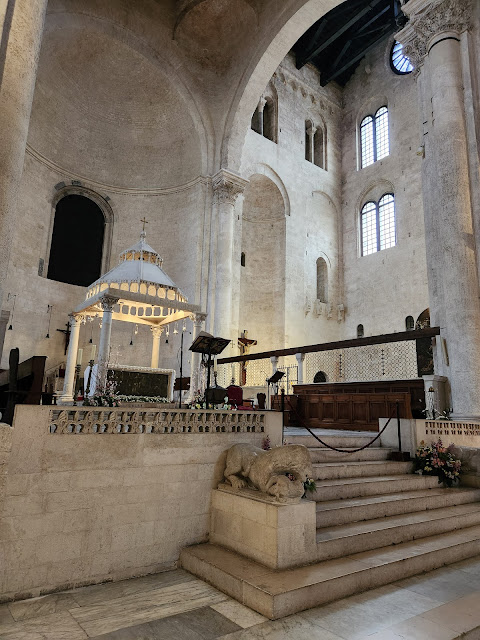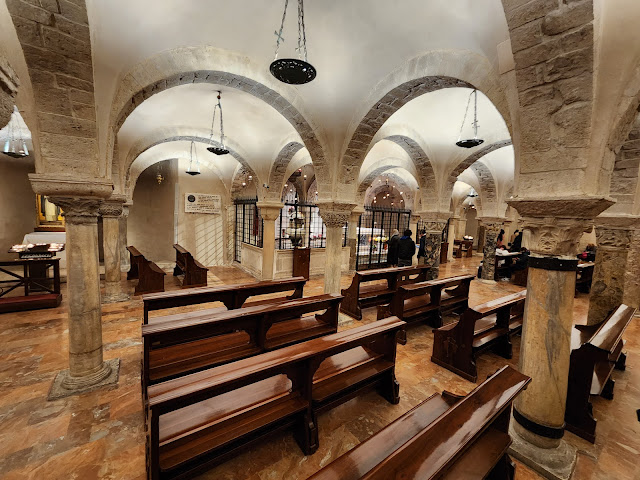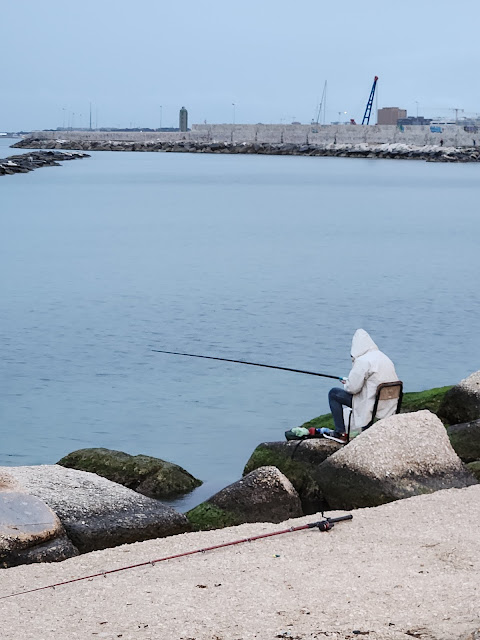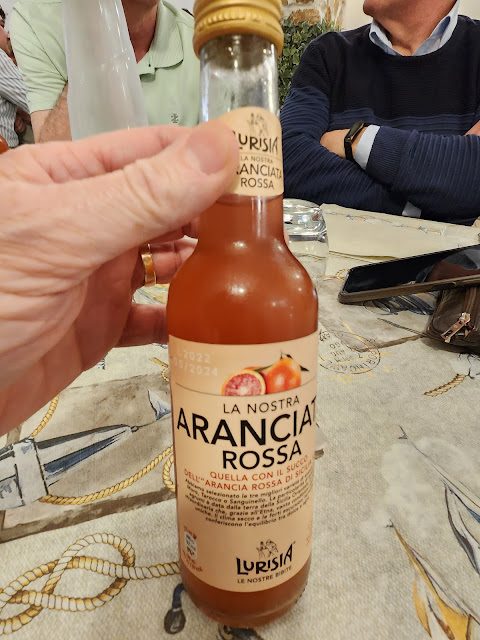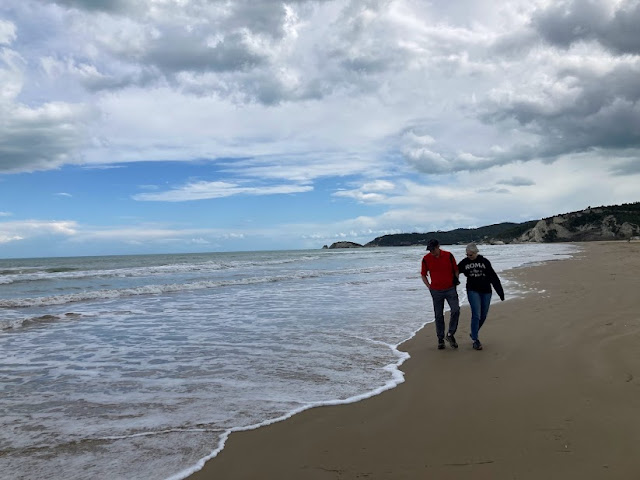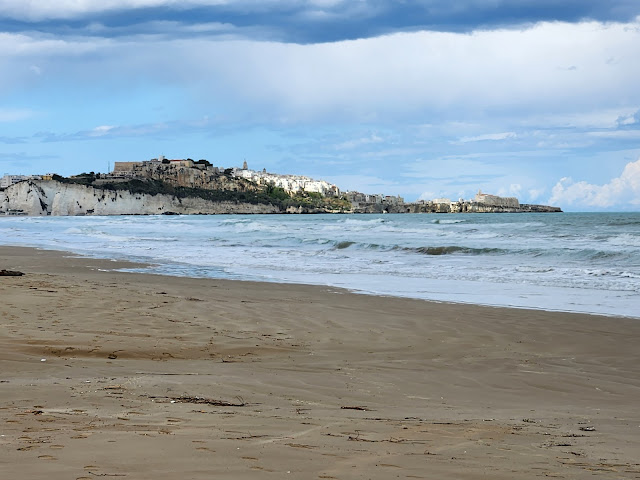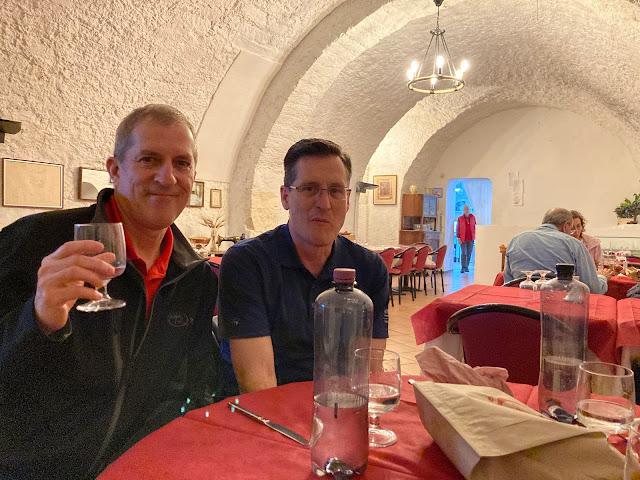Our next destination was my top choice on the pre-trip, must-visit list of locations - Bari! I think it was number-one for Ron as well. It was the first city I lived in when I arrived in Italy as a young missionary in 1982, and I spent six months there.
First up though, breakfast. We walked down to the town square and found a panificio (bakery). I went with a slice of focaccia. Ron and April did the same but with tomatoes. I should have followed suit because mine was a bit dry. But hey, after yesterday's downpour it was just so nice to sit down outside, enjoy the sunshine, warmer temperatures and good food.
We loaded our packs in the car and decided to backtrack part of the route we took the previous day. We wound our way through the narrow streets of Peschici and took the roadway along the seaside.
It was so windy that you couldn't even think about going very fast but that didn't stop the Italian drivers. They would punch it and pass, even on dangerous curves with no sightlines. Motorcycles and even a pack of bicyclists did the same. At one point, I came around a tight turn and right in the middle of the road was a whole bunch of sheep. Luckily, we didn't plow down any of them down.
One stop we had to make is perhaps Gargano's signature site, the Arch of San Felice. Centuries of water and wind created the unique rock formation in the white rocks. Legend has it sea nymphs dug the arch in the stone walls in honor of Neptune, the king of the sea, and his wife Amphitrite, who visited the lands to experience a romantic holiday. The nymphs tried to make the scenery even better by forming additional rock monuments and sea caves.
 |
| Arco di San Felice with Vieste off in the distance |
 |
| Sanpellegrino aranciata? Yes please |
We continued south and eventually made our way to Bari. I wasn't thrilled with driving into a big city because, well you know, crazy drivers and all. But again, thanks to great navigation help, we had no issues at all. It was also nice that the car drop off zone was not in the heart of Bari. We filled the car with gas ($1.80 Euro for one liter = $6.85 per gallon in U.S. currency), drove right to the Hertz office, checked it in, put our packs on our backs and headed out on foot thanks to some accurate directions from a friend named Google.
It didn't take long until Ron and I realized this was not the same Bari we knew from years long since passed. We made our way down the main pedestrian thoroughfare (which wasn't there before) loaded with big name, stylish, chic businesses on both sides of the walkway. The changes only continued as we transitioned into Bari Vecchia, or the old town of Bari, with sites dating back to the 13th century. When we lived in Bari, Bari Vecchia was dark, run down and, to be honest, not a place you wanted to be after the sun went down. Now it was bright, vibrant, cleaned up and just plain beautiful.
 |
| Entrance to our Bari apartment - second on the left |
Given that it was day-five of our trip, and we were living out of our backpacks, we were all about out of clothes so we needed to do laundry. Forty years ago, we would wash our clothes in a washing machine and then dry them either out on a balcony clothesline or on interior drying backs. Surely, Italians would have adopted clothes dryers by now, right? Nope. None of the nine places we stayed had dryers. And this particular apartment didn't even have a washer so we had even more work to do. The Smiths went first. Once they were done and hung up their wet clothes to dry, it was our turn. Lori handled wash-by-hand duty in a large sink on the balcony. Then I took the sudsy clothes inside, rinsed and wringed them in the kitchen sink, and hung them on the clothesline, kitchen chairs and on a ladder we set up in the kitchen because we needed more room to hang clothes.
 |
| Doing laundry in the shadow of the Bari Cathedral |
After a short walk deeper into Bari Vecchia, I stood in the first place since I'd returned to Italy that I recognized and vividly remembered from my missionary service. There it was, towering above me - the Bari Cathedral. Built between the 12th and 13th centuries, it was constructed on the ruins of a Byzantine cathedral destroyed in 1156 by William the Wicked, the second king of Sicily. Inside, it was cavernous yet majestic.
I have some history of my own in this building. One thing we tried to always do as missionaries was whenever we were to walk past a church of any age or denomination, we would go in and visit with the clergy inside. In the fall of 1982, my companion at the time was Anziano Ensign. We chatted with leadership inside the cathedral and worked out an agreement to visit once a week for an hour and he would play the organ. While he did that, I would make the rounds inside the church and talk to locals and visitors. It was really, really cool. Ensign would play rocking LDS church hymns and I would be spreading the good word about our church within the historic Catholic building. (I don't think local leadership knew what I was doing.) Good times indeed.
We had a date that evening to meet some of Ron's friends so we had more time to kill. I popped my head into a business and asked in Italian, "Where is the nearest place to find gelato?"
"Are you American?" she responded.
"Is my Italian that poor?" I asked.
She chuckled and said this in English, "I just want to better help you out."
She told us the best gelato in Italy was just across from the old castle. A close walk, we were there in just a few minutes. As we stood in line outside Gentile Gelateria, we noticed the sign said "Since 1880." Wow, once again more, evidence that even Italy's recent history is a night and day difference compared to America's where even old stuff is relatively new. I ordered half lemon (shocker huh?) and half vanilla with chocolate chips in it while Lori went with cinnamon chocolate. The four of us sat and ate on a small wall in front of the castle. Was it the best gelato in Italy? Well, we had many more gelaterias to check out but it presented a strong case!
Once fully satisfied, we decided to take a walk through Castelo Svevi di Bari. It dates back to 1132 when it was built but that King William of Sicily destroyed it not even 25 years later. Roman emperor Fredrick II ordered it rebuilt about 80 years later. Over time, different leaderships and regimes took control of it until it eventually became a prison and a barracks prior to today's museum. If it looks like it used to have a moat round it, it did except for the northern wall which used to border the Adriatic Sea.
Tradition has it Emperor Fredrick met St. Francis of Assisi in the castle and sent an upper class prostitute to his room. He then watched through a peephole (apparently as an ancient Peeping Tom) but Francis sent her away. Instead. impressed by his actions, Fredrick spent the night in conversation with Francis.
 |
| Looking back toward the Bari Cathedral |
 |
| St. Nicholas |
The timing of our San Nicola visit was good because mass was going on when we entered and I was hoping we'd be able to catch a service during our visit. We sat in the back and followed along for another 25 minutes or so until it ended.
The rain continued to fall outside but that didn't stop us from walking a little bit along Lungomare, a seaside walkway that wraps around Bari Vecchia along the Adriatic. One portion of it is lined by 197 black cast iron street lamps. The promenade is "the" place to go for many couples, families and groups of friends. It's that way today and it was that way when I lived in Bari in 1982. In fact, we used to go there as missionaries every Sunday evening. We would set up the mostra, as we called it, or a small billboard of sorts with photos of families, the Book of Mormon and other images. The place would be packed and we would talk to those who took a moment to stop and visit with us.
Rather than keep walking in the rain, we decided to head to the rendezvous point of a restaurant where we would meet Ron's friends that evening. He had met and baptized both Marco and Vito when he was a missionary and tracked them down via Facebook later, and remained in contact. It was such a joy to watch them see each other for the first time in 40 years. There were hugs, smiles and even some tears. Marco brought his wife, Liana, with him although Vito's was at work. We sat and talked and ate and laughed and ate and talked some more (and translated for Lori and April).
Because of the way we were seated, Lori was on my left, Vito to my right and Liana was across from me so that's who I talked to for the next two hours or so. I was again surprised how much I understood was said. Here were on our fourth day in Italy and the language was really coming back to me. That is, hearing and understanding it. I struggled a bit trying to remember the words and verb conjugations. Still, it was easy enough to communicate and Vito and Liana were understanding with me. Ron was next to Marco and April on the other end of the table.
Vito shared his baptismal story with us, which is a bit of a doozy. He had a date set with Ron and his companion to get baptized along with Marco. He was 26 years old at the time but was living at home. He said his parents didn't really care about anything he did or didn't do but when they found out he wanted to be baptized into another church, they locked him in his room so he was a no-show. The next day, Vito meet up with Ron and said, "You'd better baptize me tomorrow or it may never happen." And that's exactly what happened, two days after the original baptismal date.
Vito was just so friendly and took great care to communicate with me, the American who spoke Italian like a fourth grader because of a limited vocabulary. Still, it was awesome to form a friendship with him and the others. We had a server take a few photos and when we stood to leave, Marco, Liana and Vito gave each of us a hug and a double cheek kiss. I had never been on the receiving end of such an embrace. It was so touching. Ron was teary-eyed as he expressed his great appreciation for them all. We would see Vito the next morning at church but Marco, who serve sas first counselor in the stake presidency, would be visiting another congregation and Liana would not be there.
Even though we expressed our goodbyes, we really didn't. Instead, they said, "Let's go for a walk," so off we went into Bari Vecchia and then along Lungomare. We must've spent another hour to 90 minutes walking, talking and enjoying each other's company. It was hard to see this 40-year reunion come to an end but it eventually did sometime well after 11 o'clock.
What a wonderful evening! To spend it with loved ones, new friends, great food and in a country we love made it more than just memorable!














